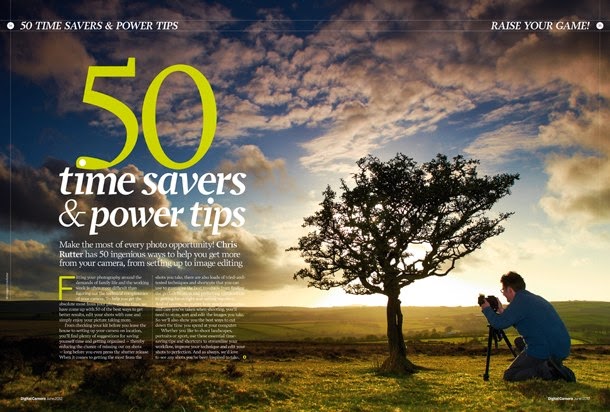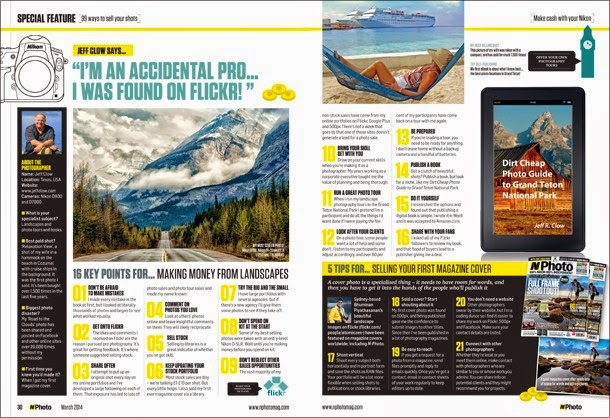How to get your pictures featured in the best photography magazines
Digital Camera World is the official website of Digital
Camera magazine, the best-selling photography magazine in the UK. But now it’s
also the home to more of the world’s best photography magazines than
ever before!
N-Photo is the UK’s best-loved Nikon magazine, while
PhotoPlus is the only photography mag for Canon photographers available in
stores.
And finally there’s Practical Photoshop, the essential
monthly read if you want to improve your photo editing and learn new image
manipulation skills.
The editors are always on the lookout for exciting new
photographers to feature on the pages of these magazines, but what’s the best
way to approach them and get your pictures published? Here are our 5 top tips:
1. Make a speculative magazine submission by email
The days of sending in a CD and a contact sheet to a magazine are long gone. An initial submission of 5-10 low resolution JPEGs by email, along with a link to your online gallery is the way to get noticed by a time-strapped magazine editor.
Make sure the photos are low res (72 dpi) and not full size
– consider something in the order of 1200 pixels along the longest length as a
good starting point.
Obviously it goes without saying that you should be able to
lay your hands on the high resolution file without any trouble. You may be
surprised to hear that this isn’t always the case!
Don’t be too concerned if you don’t hear back from the
magazine immediately. The team could be on deadline when your submission hits
their email inbox, and they’ll have other priorities, such as making sure the
next edition of your favorite photography magazine gets out of the door.
A follow-up email 1-2 weeks later to check that your photos
arrived is more than acceptable, though.
2. Make regular submissions
Photo magazines receive speculative submissions from photographers daily, so don’t be surprised if your first set of pictures isn’t selected.
It doesn’t mean you should give up. There could be any
number of reasons why the team couldn’t feature your pictures.
For instance, a photo may be artistically and technically
superb, but if the magazine has only recently printed a similar style of shot
them it’s unlikely to want to print another shortly afterwards.
Your photos may not be timely enough, either. Magazine teams
do keep a note of photographers whose pictures may not fit into the current
issue, so it may be worth a punt if you believe your picture edges one that’s
already been printed.
But there’s little point in sending an editor, an autumn or
fall picture in December, because the team will be working on their winter and
spring issues.
Being persistent without being pushy is key. Be upfront if
you’ve sent your photos to another photography magazine, too.
Photography magazine editors are unlikely to feature your
pictures again if they end up publishing an identical image as another
photography magazine in the same month.
3. Make sure your photos cut it technically
Photo magazine editors are looking for original images that capture a moment, evoke a response or illustrate a photographic concept or technique. But they need those photos to be technically top-drawer too.
Be honest with yourself: is the image sharp (if indeed it’s
supposed to be sharp), properly exposed and processed with care?
Pixel peeping often gets a bad press, but it’s the best
thing to do when you want to get your photo featured in a photography magazine.
View your images at 100% and check them thoroughly, as that’s exactly what the
magazine’s designers and editors will do.
When it comes to file size, the bigger the better.
Photography magazines are typically A4 in size, and a portrait-format image,
printed at full-page size should be 30cm high at a resolution of 300 dpi.
A landscape-format image should ideally be 45cm wide, which
will enable the magazine’s art editor to use the image ‘full bleed’ across a
magazine spread should they need to.
Don’t be disheartened if your digital camera doesn’t produce
images large enough to meet these size requirements.
If your picture is good enough, the magazine team can often
make slight design changes or lower the resolution slightly in order to hit the
required print size. And besides, not all images are printed full bleed anyway.
However, this is another good reason for getting a
picture right in camera. If you routinely crop your images, then this will
reduce the size at which they can be printed.
If you’re packing a high-resolution DSLR like the Nikon
D810, then you’ll obviously have more room to play with, but it’s something to
be aware of if you shoot with a comparatively low-res camera.
4. Leave room for text on your photos
Magazine teams aren’t just looking for perfectly framed pictures, they’re also looking for images that work within the framework of page layouts.
For instance, if you want to see your photo on the cover of
a magazine, then you’re going to have to leave some clear space for the
magazine’s art editor to drop in the logo and cover lines.
It’s a similar consideration when it comes to the opening
‘dps’ (double page spread) of a magazine feature – is there some ‘dead space’
to drop in the title of the article along with some copy?
At first it feels unnatural, having to reframe your tightly
composed shot to include excessive space. But it doesn’t take much effort to
fire off one or two of these looser compositions when you’ve got the original
shot in the bag – and it could increase the chances of your pictures being
featured.
5. Offer something more than just your best photo
To increase the chances of your pictures being featured, consider how you offer additional value to the magazine editor.
As well as finding glorious pictures for reader gallery sections,
editors and designers are always on the lookout for images that can be used to
illustrate photography technique articles. Would your photos be a good fit?
Deliberately shooting ‘wrong’ versions of a picture, as well
as the ‘correct’ one can be useful. For example, if you have a great photo of a
landscape taken with a ND grad filter, can you supply versions of the same shot
without the filter in place?
How about before/after shots showing any photo editing or
photo manipulation you’ve carried out?
Magazine editors are likely to be interested in interesting
photo stories too. Do you have a small portfolio of pictures that tells an
interesting story in an interesting way?
Don’t overlook other sections of the magazine that feature
reader pictures, such as PhotoPlus magazine’s Your Photos or Apprentice
sections or N-Photo’s ‘Over to you’ regular.
If you’re new to photography, why not send your pictures
into Digital Camera magazine’s ‘Rate my photo’ and get some expert feedback on
your pictures.
How to contact the world’s best photography magazines:
Digital Camera magazine
Email: digitalcamera@futurenet.com
Facebook: www.facebook.com/Digitalcameraworld
Twitter: twitter.com/dcammag
Facebook: www.facebook.com/Digitalcameraworld
Twitter: twitter.com/dcammag
PhotoPlus magazine
Email: photoplus@futurenet.comFacebook: www.facebook.com/PhotoPlusMag
Twitter: twitter.com/photoplusmag
N-Photo magazine
Email: nphoto@futurenet.comFacebook: www.facebook.com/NPhotomag
Twitter: twitter.com/nphotomag
Practical Photoshop magazine
Email: practicalphotoshop@futurenet.com
Facebook:
Email: practicalphotoshop@futurenet.comFacebook: www.facebook.com/practicalphotoshop
Twitter: twitter.com/pracphotoshop






No comments:
Post a Comment